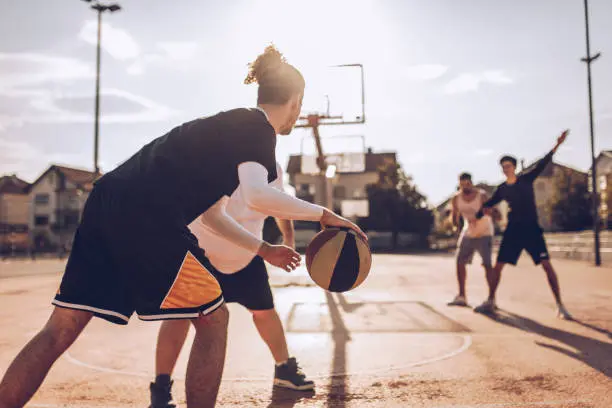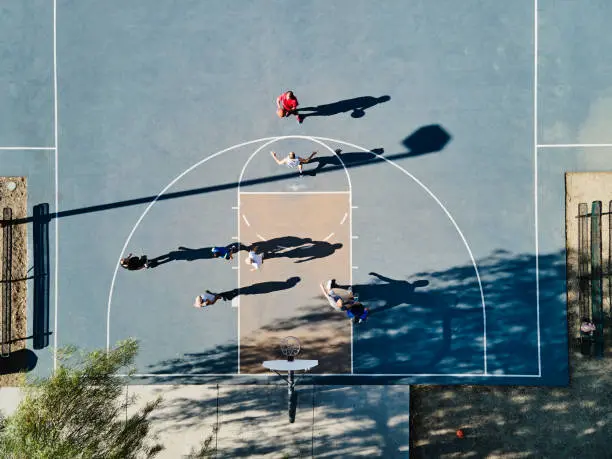Why Do Basketball Players Check In the Ball?
Across non-regulation basketball games throughout the world, basketball players will check the ball in to commence start of the game and to indicate the ball being live and in-play. A universally accepted means to start the game, the check in is widely used during pick-up basketball games and unofficial basketball games in the gym.
Below, we are going to look at and discuss just what a check in is, why do basketball players check in the ball, and in what circumstances is a check in warranted. In addition, we will look at why the check in is not utilized in the NBA, when a check in is not warranted, and just how to check in the ball properly.

What is a “Check In” in Basketball?
A check in, quite simply, is a maneuver or play done before the start of a non-regulation basketball game to indicate the ball is live and in play. Done as a means to ensure readiness and commencement of the game or the next play, the check in is widely used in pick up games and non-regulation ones.
The reasoning for the check in is that unlike in a regulation game, with numerous officials and referees, an unofficial game does not have those resources or officials to control the flow and start of the game. Rather, players are expected to control the flow of the game on their own and the check in allows for all players to be aware that the next play has begun.
A check in, then, is simply an unofficial indicator to all players on the court that the start of the game, or the start of the next play, has begun. By checking the ball in, all players are made aware that the play is about to commence and can get themselves situated for the start of the play.

How is a Check In Done?
The check in is one of the most simple and easily understood traditions in a basketball game. However, for newer players, the check in can be a bit confusing. We want to dispel those myths of the check in being difficult and assure you that the check in, and its process, is quite simple and easy to learn.
To perform a check in, a player from the offensive team will stand at the top of the three-point line arc. He or she will take control of the basketball and pass the ball to an opposing player, typically the one who is guarding them, who is also standing at the top of the arc and is typically a few feet away from them.
The initial pass from the offensive player to the defensive one can either be a bounce pass or a chest pass, however, more typically, the pass will be a bounce pass, with a chest pass being seen as a more aggressive pass and unnecessary.
Once the basketball is passed to the defensive player, they will typically complete a quick look around to ensure that players on their team are ready to commence the start of the game. Once confirmed, the defensive player will pass the ball back to the offensive player, completing the flow of the check in process.

When is a Check In Warranted?
Admittedly, the check in is not always warranted and should not be used in all situations. In particular, if you are playing a pick-up game utilizing the entirety of the court, that is each team is shooting on opposite ends of the basket, then the check in process will not need to be utilized to commence an offensive play by either team.
However, if you are playing a half-court game of basketball, then the check in will be more widely utilized. Below, we are going to go through each scenario in which the check in is warranted and will differentiate between half-court or full court play.
- The start of the game – regardless of half-court or full court play, the start of any non-regulation basketball game will begin with a check in. This is because non-regulation games do not utilize the tip-off to start the game. Rather, in a non-regulation game of basketball, the starting team will be determined by either the first player to make a shot from the three-point line or will be awarded to the team who won the previous matchup and remained on the court to face the next opponent.
- After a foul – similarly, a foul committed during a pick-up game is treated differently then one in a regulation game. Whereas, in a regulation game, a foul will typically award the offended player or team the ball or shots from the free-throw line, those rules do not extend to the pick-up game. Rather, in the pick-up game, a foul is usually only awarded to the offensive team, wherein an offensive player was fouled in the act of shooting or as they extended for a layup or dunk. In such a situation, if the foul is called, then play will be paused and a check in will be warranted to resume start of the game, with the fouled player and team maintaining possession of the basketball. This is true regardless of whether or not the game is being played on a full court or half-court setting.
- After a made basket – in the half-court setting, a made basket necessitates a check in to begin start of the next play. Whereas in a full court setting, the ball will simply be passed in as is done in a regulation game, doing so in a half-court setting is simply unfeasible. Rather, after a made basket in a half-court setting, the ball will be checked in from the top of the three-point line, regardless of which team will maintain possession of the ball after a made shot.
- If the ball goes out of bounds – similarly, regardless of whether you are playing in a half-court or full court setting, if the ball goes out of bounds, then to resume play, the ball must be checked in. The ball will be awarded to the team who did not last touch the ball prior to its being forced out of bounds.
- If there is any pause in the game – a non-regulation game is inherently different from a regulation one. Wherein a regulation game is closely monitored and kept intact, a non-regulation game can have pauses in play, whether due to interference from a loose ball from another game or two players arguing. As such, if there is any pause in the game, resumption of the game will necessitate a check in.

Does the NBA Utilize the Check In?
No, the NBA, as an official, regulated game, does not utilize the check in at any moment in the game. Rather, the NBA, via its official rules and regulations, has outlined exact scenarios on how the ball and the game shall resume play in the event of fouls, the ball falling out of bounds, or a pause in the game.
In the NBA, as the game is played in a full court setting, the ball will typically be passed in to resume play. Similarly, fouls in the NBA will be treated differently then in a pick-up, non-regulation game, with the fouled player or team receiving possession of the ball or compensated with free-throw shots.
